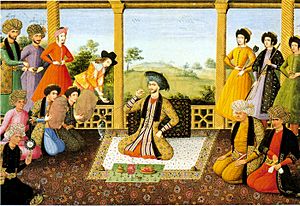Aliquli Jabbadar facts for kids
Aliquli Jabbadar was a talented artist from Iran who lived in the 1600s. He is known for being one of the first to blend traditional Safavid-era miniature painting with influences from European art. His paintings often show scenes of royal life from the Safavid dynasty. He was very good at showing small details of clothing and the places where people lived.
Contents
Aliquli Jabbadar: A Pioneer Artist
Aliquli Jabbadar's name can be found on many miniature paintings from the 17th century. These small, detailed artworks are like tiny windows into the past. He was special because he brought new ideas into the art of his time.
His Unique Artistic Style
Jabbadar's art stands out because he used ideas from European paintings. This was quite new for Persian art back then. He was also very careful about showing the details of people's clothes and the places they were in. This makes his paintings very interesting to look at.
European Influences in Art
Aliquli Jabbadar was one of the first to add European styles to traditional Persian art. This made his work unique and helped change art in Iran. He showed how different art styles could mix together.
Depicting Safavid Court Life
His paintings often show scenes from the Safavid court. This means he painted kings, princes, and their helpers. He captured what life was like for important people during the Safavid dynasty.
Where His Art Can Be Found
You can find Aliquli Jabbadar's paintings in famous museums around the world. Four of his works are in the State Hermitage in Russia. Another four are in the Metropolitan Museum of Art in the United States.
Famous Museums Displaying His Work
Having his art in these big museums shows how important Aliquli Jabbadar was. The Hermitage Museum and the Metropolitan Museum of Art are very well-known. They keep his beautiful miniature paintings safe for everyone to see.
His Background and Identity
In some of his signatures, Aliquli Jabbadar called himself farangi, which means "the Frank." This word was sometimes used for Europeans. It might mean he had European roots, or more likely, that he was from Georgia and was a Christian.
Georgian Roots and Inscriptions
Two of his paintings even have writing in the Georgian alphabet. This gives us a clue about his background. It suggests he might have been from Georgia, a country near Iran.
Rising Through the Ranks at Court
He also used other titles in his signatures. He called himself ghulāmzāda-i qadimi (which means "former slave"). He also used beg ("lord"), naqqash-bashi ("head of mosaics"), and jabbadār ("keeper of the armory"). These titles suggest he was a ghulām, someone who started as a servant but rose to important positions in the Safavid court. This shows he was a very skilled and respected person.
See also
 In Spanish: Aliquli Jabbadar para niños
In Spanish: Aliquli Jabbadar para niños




